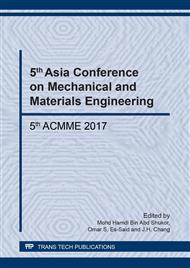p.225
p.231
p.237
p.243
p.249
p.255
p.263
p.269
p.275
Exhaust Emission Reduction from Compression Ignition Engine by Using Palm Biodiesel Blended with Nano Zinc Oxide Additive
Abstract:
Biofuel modifications play a major role in a substitution for fossil fuel to be used in diesel engines and reducing exhaust emission. The most amounts of crude palm oil produced from Asian region can be an alternative fuel, sustainably. By the modifying crude palm oil into pure palm oil biodiesel (POB100), alkali trans-esterification procedure was operated. In the present, the high-quality POB products have been investigated considerably for alternative fuel in 4-cylinders high-speed diesel engine. The aim of this paper is to study in the improvement of POB quality by repeated-distillation and blending POB with nanoZnO additive. The high-speed engine combustion from consuming blended POB fuel were investigated the influences of exhaust emission under speed engine operation of 2,000 rpm and 3,000 rpm. The experimental results were shown that the POB fuel yielded at 84.54% from using 400 g. of raw materials. Both of redistilled POB and POB blended with nanoZnO additive showed the improvement of physical properties including viscosity, specific gravity and cetane number values being under ASTM standard values for high-speed engine. In addition, the results of exhaust emission from the engine showed the effective decrease of carbon monoxide (CO), carbon dioxide (CO2) around 13% due to using redistilled POB and POB blended nanoZnO additive compared with diesel fuel. Unburned hydrocarbon (HC) and nitric oxide (NOx) emissions of the diesel fuel condition. Therefore, this study suggests that nanoZnO blending POB in the small fraction about 0.005 wt% is able to provide the high potentiality for as a clean and alternative fuel.
Info:
Periodical:
Pages:
249-254
Citation:
Online since:
November 2017
Authors:
Price:
Сopyright:
© 2017 Trans Tech Publications Ltd. All Rights Reserved
Share:
Citation:


